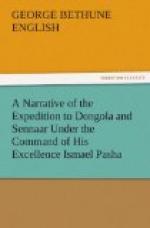[Footnote 36: I feel myself, however, bound in conscience to tell the whole truth of this affair. In perambulating about the town, in the course of the day, which was very hot, I got affected by a coup de soleil, which gave me a violent fever and head-ache. I have strong suspicions that this circumstance acted as a powerful “preventer stay” to my virtue, and enabled me to put the devil to flight on this trying occasion. The mother of these damsels appeared to be edified by the discourse I made to her upon the subject of her proposal, but the young women plainly told me, that I was “rajil batal,” i.e. a man good for nothing. If they could have understood Latin, I should have told them,
“Quodcunque ostendes mihi sic-k Invalidus odi.”]
[Footnote 37: The ordinary price of a virgin wife in Berber, is a horse, which the bridegroom is obliged to present to the father of the girl he demands in marriage. I remember asking a young peasant, of whom I bought some provisions one day in Berber, “why he did not marry?” He pointed to a colt in the yard, and told me that “when the colt became big enough, he should take a wife.”]
[Footnote 38: This learned soldier somewhat surprised me, on my demanding “why he did not give the title of Caliph to the Padischah?” by answering that there had been no Caliph since Ali, and that the Padischah was only “Emir el Moumenim,” i.e. “commander of the true believers.”]
[Footnote 39: This word is Hebrew, and signifies “a lamb.”]
[Footnote 40: Abdin Cacheff is a very brave and respectable man, of about fifty years of age. He treated me with great politeness and consideration. He distinguished himself greatly at the battle near Courty, fighting Ills way into the mass of the enemy and out again, twice or thrice on that day.]
[Footnote 41: In order to save the artillery horses for the exigencies of battle, the cannon were drawn by camels from the third cataract to Sennaar, and the horses were led harnessed by their respective guns, ready to be clapped on if necessary. I venture to recommend the same procedure in all marches of artillery in the east.]
[Footnote 42: The other side of the river, at least as often and as far as we could see it, presented the same appearance. The only mountains we saw on the other side of the river, were those of “Attar Baal,” at the foot of which (they lie near the river, about three days march north of Shendi) are, as I have learned, to be seen the ruins of a city, temples, and fifty-four pyramids. This, I am inclined to believe, was the site of the famous Meroe, the capital of the island of that name. The territory in which these ruins are found is in fact nearly surrounded by rivers, being bounded on the west by the Nile, on the south by the rivers Ratt and Dander, and on the north by the Bahar el Uswood. All these three rivers empty into the Nile.]
[Footnote 43: The butter of the countries on the Upper Nile is liquid, like that of Egypt. That, however, which they use to anoint themselves is of the color and consistence of European butter. We used the latter in preference, in our cookery.]




